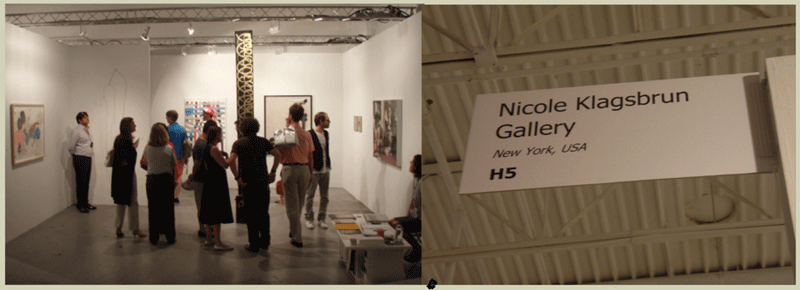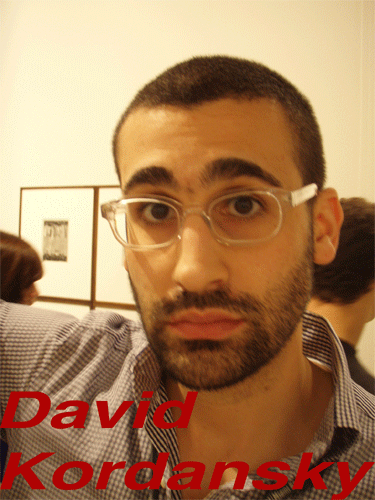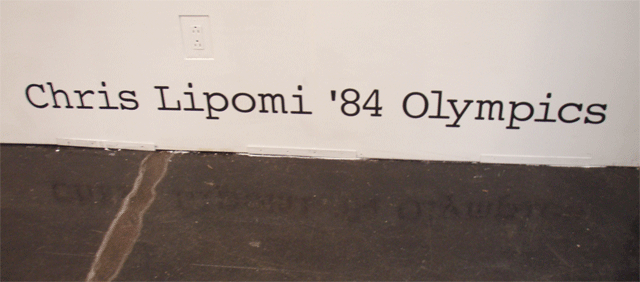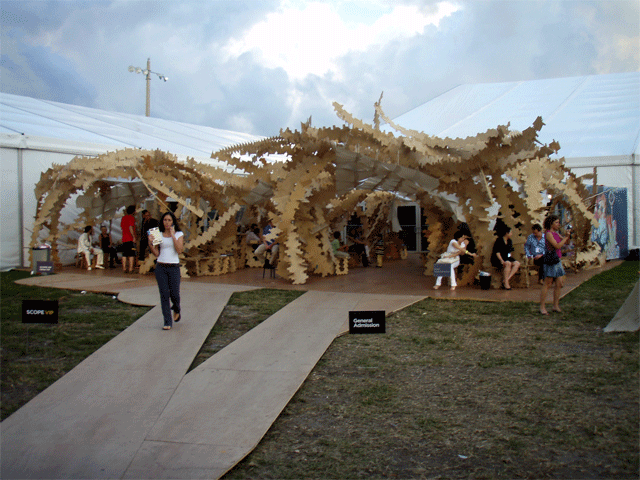December 7, 2007
ArtBasel Thursday, Friday and Saturday

First up: how was the fair?
It was like last years fair, but a little bit better.
And bigger.
What are the top five most memorable art works that you saw there?
I didn't see the artwork in any comprehensive way. That was impossible for all the people, the ones you don't know (the thick crowds) and the ones you did (great reunions with rapid cheek kissing, brazos all round and shoulder clapping).
Each fair was substantial enough to require at least a minimum of a day to see the work, and there were something like 23 or 24 fairs in Miami that week. Many times, I would be diving in and out with a specific mission (trying to make time to see other fairs) to be pulled back in several times with a pleasantly surprising rendezvous, usually leading to introductions to cool new people.
I love to kiss cheeks. It's such a lovely moment.

Glimpses.
That's how I saw the artwork in the fair, in glimpses. I saw a lot of details. I looked for anything that made me want to get back in the studio. I love that feeling. I was mercenary. I looked for artwork that would buzz saw me with both the desire to devour it and the need to get my hands on some art material asap.
Otherwise, I saw a lot of cleverness, and much insight. Lots of universes. I like to say that there are many art worlds... (That should be an aphorism! And so it now is.) If to be an artist is to recognize one's affinities and make them vivid, then there was a measure of vividness in the fair, or at least what I saw last week. However, most of it was of a personal nature, there was little of anything that addressed the public at large either by critique or proclamation or prescriptively. For example there was an installation by Buchel, but the ambitious ?Training Ground for Training Ground for Democracy? seemed absurdly small tucked away in the back of Hauser and Wirth's booth.
Art, its presentation, the business that transacts, this is one aspect... the other aspect were the parties. There were so many parties that it was impossible to visit them all, even to know how many there were at any one time. And the formal programmed party arrangements played a minor role, the most fun I had was bumping into old and new pals and goofing along the way. It was the endless hook ups with friends where fragments of information flowed, a treasure of intoxicating social nectar, threads to weave a picture of the art world at large.
I should pause and salute my compadres who were manning the gallery booths in the fairs. They were not able to cruise as freely as I, having to stay on station for long hours each day not only during the fair, but also before and after it for set up and strike down. Every night, they had to mind their time, else a rip tide of festivities would steal their sleep, blunting the jet pilot-like mercantile skills needed to run a successful venture there. Even when they were able to tag team to get out to see the art at large, the combination of long hours of logistical coordination, negotiations with clients, networking and finally the sheer density of artwork to view... all this would result in a kind of stunned shell shock look to their faces. The only saving grace is that their stress seemed to be at least one step back from the debilitating type that would turn the experience towards tragedy. Finally, the fair was successful enough to make it all worthwhile.
*
*
*

HOT TIP: (to be read as a hoarse & low whisper) Rent a scooter!!! Forget about the danger in the street, it's not so bad! And they have no helmet laws in Florida! How wonderful! After you get a hang for it, you are supremely safe out on the road. On a scooter, you are much more aware of your surroundings that the folks in the cars around you... and for that you have to lean into the traffic and take charge a bit. But that's fun! Go slow and be prudent and all will be well. And then once in a while when the coast is clear, you can throttle fast and lusty, but just for a moment or two.
C'mon, you've got to live a little.
On a scooter, you are so free. You can see more of the fair and the city too. And urbanistically, Miami is very comprehensible with the beach on one side and the urban core across the bay, the port to the south. Distances are far enough to discourage walking (I felt as if I walked more there than I did in NYC with much less to see along the way compared to Manhattan), and far enough to make the taxi fares irritating. The weather was so warm in this December that even at midnight, a t-shirt and sandals are sufficient as you split lanes in a traffic jam on Collins Avenue. And without a scooter, you are either walking way too much or paying too much for taxis the whole week.

*
*
*
Glamour.
Miami is all about the vavoom. Sexy, sexy. Well or badly done, the folks that usually spill out onto Collins Avenue are usually trying to dress to the nines. Hot sexy women are regularly stepping across your path (sorry, I didn't notice the men in this regard... my sensory and limbic systems were distracted or overloaded). Most certainly this is because Miami is uniquely Latinized with the upper crust of the Caribbean, Central and South America.
I think of Miami as the most European or international of American (USA) cities. I heard Italian, French and German regularly. Spanish and English mix everywhere in the city. Occasionally, I would encounter Latinos who would not speak English either because of inability or stubborn preference. It was normal to hear both and among the locals, English and Spanish would swap back and forth freely. And I love Cuban Spanish, so clear and well formed it is.
*
*
*

Bidness, so much bidness.
The sheer scale of money is mind bending. Private jets are all the mode among the elite collecting class, better to ferry cargo in and out without question. Single hand held objects are selling for prices that are in increments of the value of my house. And in more than a few galleries, art objects are blowing out, most everything is selling. There were no dealers singing sad songs last week. (That's all I can write about this topic at the moment. Most that can be said over a beer shouldn't be written in a blog. If you have any questions, you will just have to go to an art fair and see for yourself. Or maybe you could buy me a beer. Maybe.)
It seems the expected subprime meltdown hasn't yet dampened what many in our art world call a massive bubble of speculation in art-as-investment. Sitting on the train returning from Micha?l Amy's Quirky show in Westport Connecticut last month, I had the pleasure of chatting with a NY dealer who in passing mentioned something I have been hearing from several others in the art world (most or all are art dealers ...not any of my own by the way). It was memorable because she expressed it with such an exasperated force: they want the speculative bubble to pop, that the art world needs a correction and soon. Today.
I came across sage words from our financial wizard:
After more than a half-century observing numerous price bubbles evolve and deflate, I have reluctantly concluded that bubbles cannot be safely defused by monetary policy or other policy initiatives before the speculative fever breaks on its own. There was clearly little the world's central banks could do to temper this most recent surge in human euphoria, in some ways reminiscent of the Dutch Tulip craze of the 17th century and South Sea Bubble of the 18th century.(jump to the last paragraph)
The current credit crisis will come to an end when the overhang of inventories of newly built homes is largely liquidated, and home price deflation comes to an end. That will stabilize the now-uncertain value of the home equity that acts as a buffer for all home mortgages, but most importantly for those held as collateral for residential mortgage-backed securities. Very large losses will, no doubt, be taken as a consequence of the crisis. But after a period of protracted adjustment, the U.S. economy, and the world economy more generally, will be able to get back to business.-Alan Greenspan on The Roots of the Mortgage Crisis
Real estate bubbles don't pop (or so it seems), they deflate for a time and then they reinflate again. And it seems that for this time, the art market will go the same way, if it deflates at all. At this fair, there was positive momentum for sure, the bubble was as turgid as a Jeff Koons shiny bunny. It is interesting that after our last bubble burst in the end of the 80's (many galleries evaporated and art got real again --or so everyone says) investments went into real estate then to stocks (again) and after a time to more real estate and then to art.
It appears that private wealth found some kind of grounding in the combination of real estate and stocks and from this, the current enthusiasm in art collecting. It also seems that art collecting has become popular because it is the second or third career for the retired CEO type. It also serves as a marriage bonding activity for couples in their mid to late careers, art collecting seems to serve either a maritally reparative function or a way to intensify the relationship. Think about it: a couple who has the assets and the time can immerse themselves into art history, participate in the dialog and the social circles that compete for honors in the museum/gallery world, travel and sightsee, meet interesting new people, and the Vegas style bonus: invest $$ along the way that sometimes just might outperform the original investments that gave them the position to play in the art world in the first place, all of this happening in field of endeavor that is as yet unstructured by laws or regulation, a vast Wild West of boomtowns and highway robbers and gold in them thar hills, a primordial marketplace grounded in the hands of earnest artists and flying aloft in altitudes of profits that makes double compound interest look like sardines.
The art world has changed from a previous epoch where the chain of gallery exhibitions/critical reviews/curatorial play/museum collection has been disrupted. Most transactions have been collated more into the art fairs and less in the opening show of the gallery. The high wire vertigo of owning a gallery comes now from having to mount expensive trips to a fairs (shipping, hotels, food, parties, fees) in the hopes of making enough of a profit to do it again in the next financial quarter or so. Some do better than others, most do better and better every year.
And what of the rich and poor? The poor have become richer in that they are better off more now than at any time in human history... and the bite seems to be that the rich not only seem to get richer... but sometimes insanely, ridiculously richer. It's a red cape flashed before envy and common sense. Say what you want about the disgust of it all, but this is in the same matrix that has brought India and China out of poverty, where the central problem for old age is how to extend it, where obesity has replaced starvation and all of this is a product of the growing global marketplace.
Lucre, filthy lucre.
Meanwhile in grad schools across the country, there is no word of any of this. In what amounts to an intellectual boot camp, conceptual theory has nothing to say about the context of the marketplace, its history, the philosophy that undergirds it, the subtlety of negotiation and of property rights both physical and virtual. There was some chatter of the upcoming Whitney Biennial, of how it is a survey of conceptual art, and how it seems to be a separable world from the galavanting global merchant caravan. And don't get me wrong, boot camp was a good and memorable experience for me both in my Navy days or in grad school: the in-your-face existential challenges, the rites of extreme exertion, the regime of close attention (either by cleaning your barracks toilet or close reading text selected by others) and the feeling of initiation into an elite group (however questionable or noble).

Everyone in our multiple art world is vying for position as the center of the argument, the top of the list, the one art world that is most relevant to the turn of history. That's fair and human, as is the case that it is both granted and denied for all of us simultaneously and in turn. It bugs me that there has to be such separable worlds, this apparent division between academic conceptual theory and the marketplace. Both have to move towards the other: the art fairs providing a better forum for the dialogue and academia opening up the canon to consider Hayek as well as Marx, for example.
It is strange to consider that while most art schools are preoccupied with providing some kind of metric of career placement (successful graduates becoming artists, dealers and otherwise variously employed in institutions) as proof of validation, they do little or nothing to prepare students for the marketplace past hoary cliches such as broadcasting slide sheets (now antique), wrangling the jargon of artist's statements and press releases or teaching the unteachable such as how to network. Students paddle out into the marketplace like baby turtles who just figured out how to wriggle out of a pile of eggs on the beach.
It would be interesting for example to take a semester of grad students to anthropologically analyse the art fair: as a business, who the principal actors are, their histories, what kind of art is shown and why, the nature of the marketplace, how value dynamically manifests through multiple self interested transactions, the dimension of information and hype, the emotional aspect of the marketplace, stuff like that. And then, at the end of a fall semester, the class would fly to Miami (and all would be on scooters, naturally) and unleash a tsunami of party field "research" that could be documented and represented at the school that sent them when they get back.
Just a thought.
(But then again, all this street smart world weariness should be held in check. This type of knowledge won't help anyone make better artwork, in fact it might hurt. Remember: intrinsic value generates extrinsic value in art.)
*
*
*

People were chattering about how Chris' show had sold so successfully early in the fair. He had reproduced the painting output of Basquiat for 1984. You can pop up a detail here. NY Mag has a spicy blog entry about it here.


Chris has a piece of sculpture, chocolate house with some kind of interior video projected life within at KARMA International, the Z?rich based project-oriented gallery created by Marina Leuenberger (right, arm around friend John) and Karolina Dankow. Marina used to work for my gallery in Z?rich, Mark M?ller. We used to joke about how she was destined to open a gallery in Miami, and boom here we are a few years later with something of a close facsimile.

After shooting four composite shots of Chris Lipomi, he showed up the very next day with a new haircut, thus this attempt at a glamour shot. I instructed him in the fine points of the Tony Cu?ha? head shot: head down in a three quarter turn and look at the lens under your eyebrows, thinking all the while like a perpetrator, like you're going to take my lunch money.
GREAT JOB, CHRIS!
*
*
*

It was good to see so much of Thomas Zipp and Andr? B?tzer in the Gallerie Guido W. Baudach Rubell Family Collection.


Walking through the main gallery into the courtyard, it at first looked as if Zipp had prepared breakfast for us. His slender Alice Aycock-like folly that had people climb a drum (people occluded the structure in this shot) Later I learned that is was Rubell's daughter who served up something that looked more like art and less like life. Eggs and mozzarella and ham.
I wouldn't touch it.
Hygiene is inversely proportional to scale.

*
*
*
Rondo: Stations of ArtBasel 2007.
Taking a break at the central lounge at ArtBasel Miami Beach, I set up the camera on a plastic cocktail cup and rotated it round for a slice of the life in the fair.
*
*
*
Don't watch this, it's boring and the camera dangle will induce motion sickness.
(I just love scooters and I wanted to see how this looked.)
*
*
*

Back to NADA: as you step in, there's a Statue of Jesus mounted in the rafters to bless the enterprise.
(I'm learning that the text font size that I have been using shrinks with the format... oh well.)

Scootering over the Venetian Way Bridge was much fun. Once into the mainland above the downtown center the design district contains NADA, Pulse Scope and many other venues. Scope is set into the base of a Hatian neighborhood, or so my taxi driver told me. What seems to be a light industrial zone that is in transition into a community for the various arts, the Design District is where much of the available real estate is located. There were many for sale signs around.
For venues like Scope or Positions (by the beach), I think that it is important to redesign the festival structures every two years or so. Temporary low budget strategies don't age well.

While I was hanging out with Jean Milant (Cirrus Gallery), a cute couple of girls walked by with bags of product, sporting t-shirts with "FUCK ART" printed on them in red. Eyes roll into the sockets, vintage 80's irony.
Shortly after that, a celebrity spotted: Todd Oldham. I quickly made my exit as he turned into Jean's booth.
All week I promised myself to find live Cuban music. I queried every Latin that crossed my path. Calle Ocho in Lil' Havana seemed to be the place to go. But time was running out and finally I got a fix on a club in Miami Beach: Mang? Tropical Cafe. The whole trip was an insistent overturning of my expectations. My anticipation was that the major issue would be the burgeoning scale. But even though everyone was fried from partying and goggle eyed from sensory overload, they were after all, happy about it. Satisfied. It seems as if everyone found what they wanted from that week. By the time Saturday night rolled by, my expectation of sipping a cocktail in a Desi Arnaz style club scene (like the Silvana Mangano video, forget it. What I found was closer to Disney and not in a good way. So I booted to plan B, the ARTFORUM party at the Wolfsonian Museum of Art Deco... something I had low expectations for. And I was definitely wrong. The party was fun and low key, dancing on a crowded floor to boot. And the Wolfsonian is something I will return to someday for a closer look. The wall plaques seem to promise an alternative narrative for the emergence of the modern, and that is something I find intriguing. Few really know how to define what it is to be modern.


Leave a comment